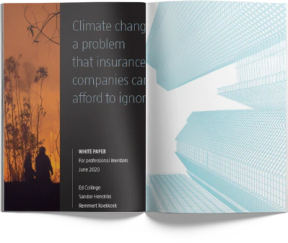It’s not only the rising costs from claims for damage to property caused by increasingly severe weather that pose the problem. Insurers invest the premiums they receive in financial markets to gain enough returns to fund their liabilities.
These investee companies are themselves exposed to climate risk, particularly through the need to decarbonize in the transition to a low-carbon economy. This creates a double whammy for insurers and it urgently needs addressing.
A new white paper from the insurance team at Robeco entitled ‘Climate change: a problem that insurance companies can’t afford to ignore’ examines the issue from multiple angles.
Double-sided threat
First, there are the costs: the ever-increasing bill for claims from storm damage or flooding raises the question about what will be insurable in the future. Businesses near the coast or on flood plains may find themselves being rejected for cover.
The far bigger problem, though, comes from where insurance money is invested. Insurers tend to invest across a wide spectrum of stocks and bonds to spread their risks and raise as much return as possible within their risk budgets.
This includes companies that are more exposed to climate change risks than others, plus those that face risks from the need to transition to a lower-carbon business model, such as fossil fuel providers and utilities.
So, what to do about it? Robeco offers its expertise in calculating the carbon risk in investment portfolios as a means of assisting insurers with this kind of risk assessment. To find out how, download our white paper today.

下載刊物
免責聲明
本文由荷宝海外投资基金管理(上海)有限公司(“荷宝上海”)编制, 本文内容仅供参考, 并不构成荷宝上海对任何人的购买或出售任何产品的建议、专业意见、要约、招揽或邀请。本文不应被视为对购买或出售任何投资产品的推荐或采用任何投资策略的建议。本文中的任何内容不得被视为有关法律、税务或投资方面的咨询, 也不表示任何投资或策略适合您的个人情况, 或以其他方式构成对您个人的推荐。 本文中所包含的信息和/或分析系根据荷宝上海所认为的可信渠道而获得的信息准备而成。荷宝上海不就其准确性、正确性、实用性或完整性作出任何陈述, 也不对因使用本文中的信息和/或分析而造成的损失承担任何责任。荷宝上海或其他任何关联机构及其董事、高级管理人员、员工均不对任何人因其依据本文所含信息而造成的任何直接或间接的损失或损害或任何其他后果承担责任或义务。 本文包含一些有关于未来业务、目标、管理纪律或其他方面的前瞻性陈述与预测, 这些陈述含有假设、风险和不确定性, 且是建立在截止到本文编写之日已有的信息之上。基于此, 我们不能保证这些前瞻性情况都会发生, 实际情况可能会与本文中的陈述具有一定的差别。我们不能保证本文中的统计信息在任何特定条件下都是准确、适当和完整的, 亦不能保证这些统计信息以及据以得出这些信息的假设能够反映荷宝上海可能遇到的市场条件或未来表现。本文中的信息是基于当前的市场情况, 这很有可能因随后的市场事件或其他原因而发生变化, 本文内容可能因此未反映最新情况,荷宝上海不负责更新本文, 或对本文中不准确或遗漏之信息进行纠正。

